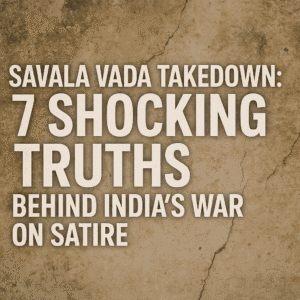Savala Vada Takedown: 7 Shocking Truths Behind India’s War on Satire
The takedown of a student-run satire page over a “legal request” reveals a democracy increasingly intolerant of dissent. With 85,000 followers, Savala Vada’s memes critiqued caste violence, controversial policies, and constitutional anxieties—like their viral “Remains of Indian Constitution Beneath Ram Mandir” post. Their opaque banning mirrors systemic pressures faced by journalists (Rana Ayyub) and comedians (Kunal Kamra), underscoring India’s 151st global press freedom rank. The creators’ defiant response—mocking a “Ministry of Unfunny” and khaki-clad priorities—highlights youth dissent weaponizing humor as political speech. Ultimately, silencing hostel-room satirists amid floods and economic crises exposes a state prioritizing image control over governance, confessing weakness through its fear of laughter.

Savala Vada Takedown: 7 Shocking Truths Behind India’s War on Satire
The blocking of Instagram satire page The Savala Vada isn’t just about deleted memes. It’s a litmus test for how India’s self-proclaimed “Mother of Democracy” treats irreverent voices questioning power. Run by university students from a Kerala hostel dorm, this 85,000-follower account joined a growing list of satirists—from cartoonist Manjul to comedian Kunal Kamra—facing legal crackdowns for mocking authority.
Why This Matters Beyond the Memes
- The Chilling Equation: When a meme page becomes “Public Enemy #1” (as creators sarcastically noted), it signals a state prioritizing image control over substantive governance. The takedown coincided with Assam floods and economic distress—timing that amplified their critique: “A government petty enough to target Instagram pages surely has the nation’s best interests at heart.”
- Opaque Censorship Machinery: Instagram’s vague “legal request” compliance highlights how digital censorship operates in shadows. Unlike court orders, these takedowns lack transparency about which laws were violated or who initiated them. This ambiguity weaponizes compliance, letting platforms become silent partners in silencing dissent.
- Generational Dissent Redefined: Savala Vada’s format—newspaper-style memes lampooning caste violence, controversial policies, and Ram Mandir politics—represents youth dissent distilled into shareable satire. Their viral “Remains of Indian Constitution Beneath Ram Mandir” post wasn’t just humor; it was a generation articulating constitutional anxiety through digital-native language.
The “Ministry of Unfunny” Strikes Back
The creators’ defiant response cuts to the heart of the issue:
“Tell us which joke struck a nerve… Do you have job postings in the Short Khaki Pants brigade?”
This jab at the RSS and demand for specificity underscores how censorship often reflects institutional insecurity. When states fear laughter, they reveal weakness—not strength.
India’s Shrinking Satire Space
- Press Freedom Context: India’s 151st global press freedom ranking (RSF, 2025) frames this takedown as systemic. Satire thrives where criticism is tolerated; its criminalization mirrors the FIRs against journalist Rana Ayyub for “derogatory” social media posts.
- The Global Playbook: Like Egypt jailing TikTokers or Turkey prosecuting meme creators, India joins regimes using “legal requests” to sanitize digital discourse. The Savala Vada team’s Onion-inspired model highlights how such satire exists globally as democratic pressure relief—except where governments lack the confidence to allow it.
The Irony of “Priorities”
As floods displace thousands and inflation bites, resources spent silencing college meme-makers expose a perverse governance hierarchy. Savala Vada’s closure isn’t about law—it’s about power’s discomfort with being held to account, even through humor. When a hostel room’s satire threatens the state, democracy isn’t just compromised; it’s parodying itself.
You must be logged in to post a comment.